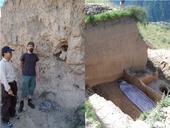Highlight
Date of human habitation in Jiuzhaigo National Park Extended
Achievement/Results
Jiuzhaigou National Park (JNP), a UNESCO World Heritage Site, is China’s premier eco-geologic tourist attraction. To facilitate improved park planning for sustainable growth we propose a comprehensive, interdisciplinary, and collaborative framework between Sichuan University (SCU), Science Department Staff at Jiuzhaigou National Park and the University of Washington (UW) for collecting data and monitoring park cultural and ecological conditions. This framework includes preliminary investigation of Jiuzhaigou’s geology and soils, a comprehensive archaeological survey of the upper villages in Yala valley and ethno-historical review, as well as an ecological assessment of current and historical landscapes. Our interdisciplinary studies focused on three major topics: (1) what was the history of indigenous culture in this park, (2) how has this historical occupation of the park influence park landscape and biodiversity features, and (3) how might current park management policies incorporate this knowledge into their practices?
Anthropological, archaeological, ecological and geological investigations conducted jointly by researchers from JNP, SU, and UW during April ? May 2006, June 2007, and September 2008 identified the first three possible archaeological sites in the park. Of particular interest is the Asono site around the village of Jian Pan. Our team now believes this site to be between 2,000 and 3,000 years old. Even more importantly, Asono is one of the largest prehistoric sites in all of Aba Prefecture. Hundreds of artifacts including pottery, bone, charcoal, milling stone, etc. have been found at Asono, including some that may be as much as 3,000 years old. Asono will be invaluable for:
- Understanding the history of human habitation in Jiuzhaigou
- Examining the relationship between humans and the environment
- Investigating geologic processes and their anthropogenic and natural causes
- Fulfilling standards set forth in the UNESCO World Heritage Conventions
We have some incredible photographs illustrating the present Tibetan Village (stupa and prayer flags), the terracettes, the 35 square meter excavation and the associated small and large artifacts. Students from cohort I, II and III were involved in this endeavor.
Address Goals
This research was only possible because of the combination of multi-cultural and national collaboration and the use of an interdisciplinary focus where Ph.D. students specializing in anthropology, archaeology, ecology, geology and soil science from a Chinese and a North American university, working closely with Park staff, were able to piece together the role of an unique geological feature (loess hillslope terracettes) with the location of historical and current Tibetan villages and their land use practices. The discovery of a buried village enable the archaeologist to extend the dates of human habitation in this valley from about 600 to almost 3000 years. Ecologists documented the unique ecological features of these special landscapes. Students saw how disciplinary expertise became much more powerful when placed in a true interdisciplinary context. Clarifying this human-environment relationship through interdisciplinary methods was invaluable for stating the ecological and cultural significance of these terraces.






